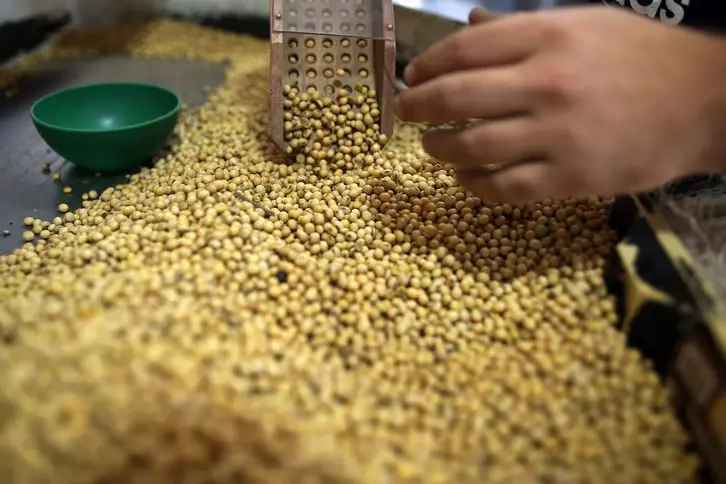PHOTO
FORT COLLINS, Colo.- Faulty U.S. planting expectations caused shock among market participants when the government published its acreage survey two weeks ago, and with a fresh set of numbers on deck for Thursday, it may be helpful to compare the predictions with historical outcomes to minimize the chances for more surprises.
The U.S. Department of Agriculture World Board will publish its monthly world supply and demand report (WASDE) on Thursday at noon EDT (1600 GMT). Although changes to U.S. corn and soybean production usually do not come until August, this year’s extreme weather has caused everyone to scrutinize these numbers earlier and more closely than usual.
Analysts predict U.S. corn production to fall fractionally from the June estimate to 13.664 billion bushels, while soybean output is seen down 6% at 3.883 billion bushels. The estimates suggest that some analysts expect that USDA’s World Agriculture Outlook Board (WAOB) will not use the exact area numbers from the June survey.
In its July report, WAOB traditionally adopts the planted and harvested area figures from the June survey conducted by USDA’s National Agricultural Statistics Service (NASS). This is because there is almost never enough evidence between mid-June and early July to suggest a different number, and USDA makes adjustments only when there is solid data to support a move.
If yields are not adjusted from June, taking the new harvested areas from NASS would place corn production at 13.877 billion bushels, up 1.4% from June, and soybean output at 3.924 billion bushels, down 5.4% from June.
WAOB made a large cut to corn yield last month, and corn yields are rarely altered in both months, so a change to soybean yield could be the more likely scenario based on late planting and emergence.
It is important to remember that Thursday’s yields are model-based, not based on surveys or actual field measurements. Those data points will help formulate the estimates in August and September, respectively. Satellite imagery will also be a factor at those times.
PLANTING PRECEDENCE
There has been only one time in history that USDA did not directly adopt the area estimates for corn and soybeans from the NASS June survey in its July WASDE. That was in 1993, when corn harvested acres came in 0.8 million below what the NASS survey suggested. Corn plantings were unchanged.
The change to soybean area that year was more drastic. Relative to the NASS survey, WAOB reduced soybean plantings in July by 2.1 million acres and harvested area by 2.5 million acres.
The July 1993 adjustments were based on “extraordinary weather conditions in the upper Mississippi and lower Missouri Valleys” after “excessive rainfall in the region since mid-June.” Too much rainfall during that late time frame is more likely to impact soybean plantings than those for corn.
WAOB would need to have observed significantly anomalous conditions since the conclusion of the NASS survey in mid-June to warrant changing area from the June 28 report. Without concrete evidence, an area adjustment is simply too speculative for how the agency operates.
Since mid-June, the areas that have experienced the most excessive rainfall are on the periphery of the main growing regions. That makes a less convincing case for USDA to adjust area on Thursday compared with 1993, when the late June deluge was centered on Iowa.
YIELD TWEAKS AND TRACK RECORD
In the past 25 years, USDA changed corn yield in July eight times. Three were increases – 1994, 1999 and 2003 – with gains between 3 and 4 bushels per acre from the June forecast.
Five of the changes were reductions, with the lightest at 0.5 bpa in 2008 and the heaviest at 20 bpa in 2012. USDA cut corn yield by 3 bpa in both 1996 and 2005, and it took off nearly 5 bpa in 1993.
Past July yield adjustments were generally the result of crop conditions at the time, including the extreme hot and dry weather observed in 2012. It is important to note that in this case, "crop conditions" is cited in the general sense, not as it pertains to the amount of crop NASS has placed in excellent condition, good condition, and so on.
Five of the eight July corn yield tweaks were ultimately the correct call, with final yield swinging the same way as the change. The ones that were incorrect – 1996, 2005 and 2008 – went on to record a final yield higher than was predicted in June.
USDA already made an unprecedented corn yield cut of 10 bpa between the May and June WASDE reports. The only year in which USDA changed corn yield in June and July was 2008, both reductions, and ironically both were the wrong call as final yield landed very close to the long-term trend.
In fact, the previous three June corn yield reductions (2008, 2009 and 2013) were all in vain as final yields ended up higher. USDA adjusted corn yield in June only two other times (1995 and 2002) and the moves eventually proved correct.
The average trade guess for corn yield on Thursday is 165 bpa, just 1 bushel below the June peg.
USDA has adjusted soybean yield in the July WASDE five times in the past 25 years. The only increase was in 1994 of 0.5 bpa, which turned out to be the right idea as yields soared 16% above trend that year.
The July soybean yield reductions came in 1993, 2004, 2008 and 2012, with the largest cut of 3.4 bpa observed in the most recent year. The only incorrect call directionally was 2004, but the trim was small at 0.1 bpa and the support came from a shift in acreage distribution as indicated by the June area survey.
The other three reductions were eventually supported by lower actual yields later on. The reasons for those reductions included adverse crop conditions and late planting and emergence.
USDA has twice changed soybean yield in June (1995 and 1996), but only the 1995 tweak verified. Those reasons were based on adjustments in area from March intentions following wet spring weather. Both were reductions of 0.5 bpa or less.
Last month, soybean yield was unchanged from the long-term trend of 49.5 bpa, though analysts see that figure shrinking to 48.6 bpa on Thursday.
(Editing by Matthew Lewis) ((karen.braun@thomsonreuters.com; +1 (312) 408-8059; Reuters Messaging: karen.braun.thomsonreuters.net@reuters.com; Twitter: @kannbwx))












